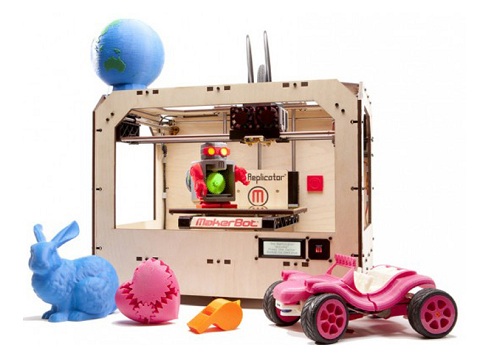3D-Printing Pro: Most People Have No Use for a 3D Printer
3D printing is not nearly as useful for the everyday consumer as you may believe, even according to those who love it.
Do you need a 3D printer?

3D printers are still somewhat expensive, but within the next few years, you'll surely have one in your home to print everything from toys to drinking cups — according to the industry's rosy predictions. Unless, of course, 3D printing is not nearly as useful for the everyday consumer as it's been hyped up to be.
"The maker will always like the 3D printer, and the enthusiast will always like the 3D printer," said Nick Allen, founder of 3DPrintUK, a professional 3D-printing outlet. "Nine out of 10 people just want the cheapest and best-quality thing — or even the cheapest thing."
Allen is a curious sort of advocate for 3D printing. He adores the technology, both for enthusiast and professional applications. Still, he has an engineering background and believes that hype for 3D printers has outstripped realism about their cost-effectiveness and eventual ubiquity.
"I'm absolutely 100 percent for [3D printing], and I wouldn't have devoted my life to it otherwise," Allen told Tom's Guide. "I want to manage people's expectations."
High costs
While 3D printers have enormous creative potential, Allen said, they will not be cost-effective for everyday use anytime in the near future. Allen points out that unless users know how to design their own products, they will likely fall back on downloading plans from the Internet, which are not always reliable.
"Files on the Internet are not moderated," he said. "Half of them don't print, and the other half pay absolutely no attention to the printability of the item and the amount of material they use."
Suppose you wanted to make a shopping basket to carry to and from the grocery store. "If you put a value to that, you'd probably say $5 or $10," Allen said. However, 3D-printing materials are expensive, and even a simple shopping basket could cost up to $3,000. "It takes a lot of time, and a lot of material," Allen said.
Conversely, small objects — even very complex ones — do not cost very much to print. "If you saw an incredibly ornate, tiny model railway engine with very high detail, you'd think, 'That's going to cost me hundreds.' But actually, that would probably cost you $10," Allen said.
This is why jewelry designers on crafts site Etsy and cosplayers (people who create and wear costumes of their favorite pop culture characters) at conventions can benefit a lot from 3D printing, but ordinary people are probably better off with manufactured goods. Printing a cup, a basket or a lamp takes a lot of material; printing a necklace from an obscure video game costs very little.
"The materials of crafting are expensive for 3D printing," said Allen. "You're not buying material; you're buying a product."
Contrary to popular belief, 3D printing does not work with raw materials, but rather plastic or metal in a highly refined, prepackaged state. "That material is manufactured into a spool — a very closely controlled powder or high-quality resin."
"You buy a product to put into your product to make another product," Allen explained. "You're just adding things to the supply chain."
AN ALTERNATE VIEW: How 3D Printing Will Save You Money
- 1
- 2
Current page: Who Needs a 3D Printer? Probably Not You - Tom’s Guide
Next Page 3D Printing Hype - Why 3D Printing Is Overhyped - Tom’s GuideSign up to get the BEST of Tom's Guide direct to your inbox.
Get instant access to breaking news, the hottest reviews, great deals and helpful tips.
Marshall Honorof is a senior editor for Tom's Guide, overseeing the site's coverage of gaming hardware and software. He comes from a science writing background, having studied paleomammalogy, biological anthropology, and the history of science and technology. After hours, you can find him practicing taekwondo or doing deep dives on classic sci-fi.
-
xroe For now it is rather useless to the general populous in terms of cost vs usability but the same could be said about the personal computer thirty years ago or the the first automobile in a time when horses were the norm.Reply -
thx1138v2 I guess this would fall into the entusiast category but I can see it being used to make replacement parts which are no longer available because the product has been discontinued. And I could see some of those parts being quite large if one can come up with a way to make it in sections and then snap them together. For that to take off, however, there needs to be good 3D scanning devices and cheap and easy 3D software for adding the snaps to the scanned pieces of the part.Reply -
thx1138v2 xroe: back when I was diddling around with my first Radio Shack Model I my girl friend's mother, who was a teacher, asked me, "But what can you _DO_ with it?" And the truth was, not much, back then. But it dawned on me when I got my first color IBM XT that the answer was just about anything you can do with a canvas and paint or pencil and paper. That pretty much includes everything that went before in the field of arts and literature. I have the distinct impression that 3D printing is in that same stage right now, maybe like Gutenberg printing press.Reply -
joneb i am 100% sure that the naysayers of 3d printing will also be on the long list of the blind who didn't see tablet computers or smart phones taking off, more than 1mb needed in a computer and so on. History is littered with failed gimmicks but also actual life changing products we often take for granted today that in the past were labelled as a fad or no one needs them.Reply -
66tbird I'm an owner of the very model machine pictured. The author nailed it 100%. My printer took a lot of modifications to get it to make great quality prints. That took more skill than the average consumer can provide. Also most people don't 'get it' when it comes to what you can print. The term 'anything within the printers build volume' just doesn't trigger anything creative in their minds. The few that do get it don't know how to create it and get into a format the machine can understand. Every printer is a little different and few files work with all printers. 3D printers(ing) for the masses is not going to happen until the IQ of the general populous jumps to another level. I don't see critical thinking going that direction anytime soon. What would you like to print that you can't buy effortlessly? I'm an inventor and a prototyper so this machine is my toolbox.Reply

